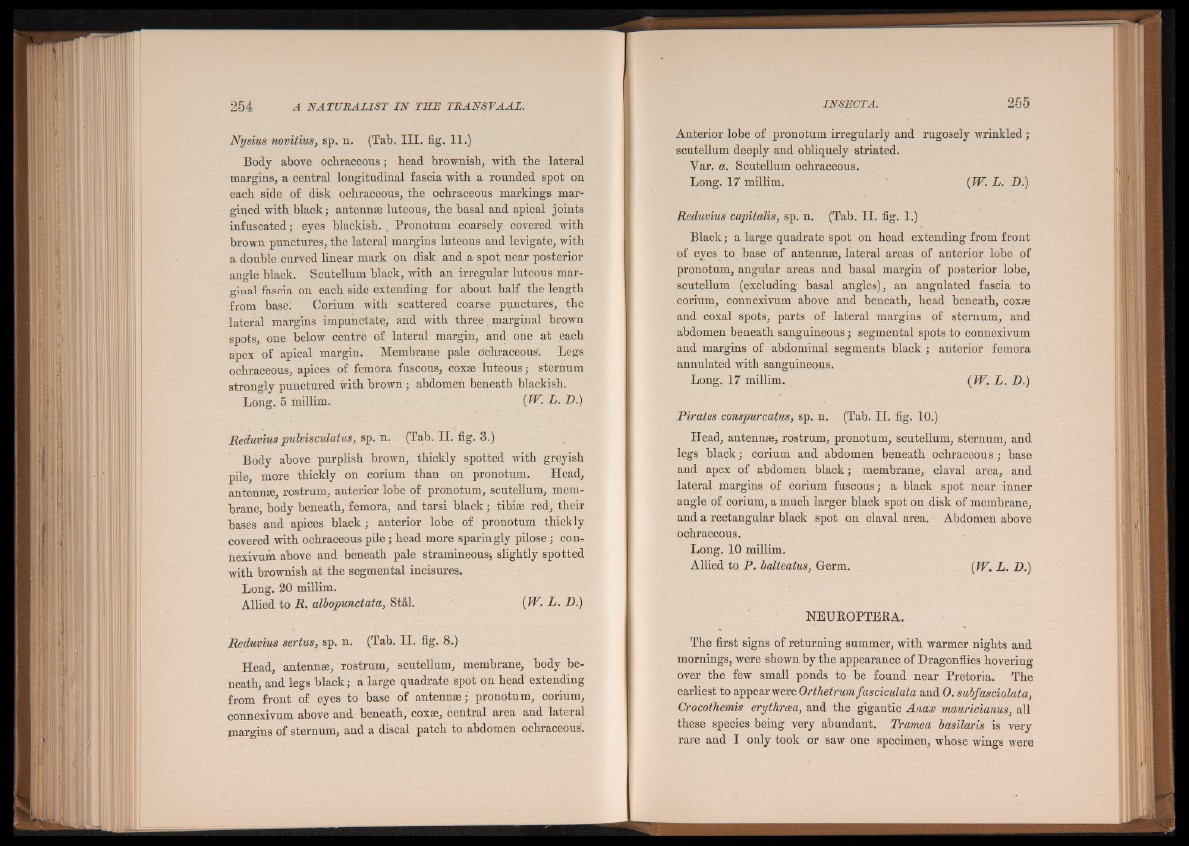
Nysius novitius, sp. n. (Tab. III. fig. 11.)
Body above ochraceous; bead brownish, with the lateral
margins, a central longitudinal fascia with a rounded spot on
each side of disk ochraceous, the ochraceous markings margined
with black; antennae luteous, the basal and apical joints
infuscated; eyes blackish. . Pronotum coarsely covered with
brown punctures, the lateral margins luteous and levigate, with
a double curved linear mark on disk and a spot near posterior
angle black. Scutellum black, with an irregular luteous marginal
fascia on each side extending for about half the length
from base: Corium with scattered coarse punctures, the
lateral margins impunctate, and with three. marginal brown
spots, one below centre of lateral margin, and one at each
apex of apical margin. Membrane pale Ochraceous’. Legs
ochraceous, apices of femora fuscous, coxae luteous; sternum
strongly punctured with brown ; abdomen beneath blackish.
Long^ 5 millim. (W. L. D.)
Reduvius pulvisculatus, sp. n. (Tab. II. fig. 3.)
Body above purplish brown, thickly spotted with greyish
pile, more thickly on corium than on pronotum. Head,
antennae, rostrum, anterior lobe of pronotum, scutellum, membrane,
body beneath, femora, and tarsi black; tibiae red, their
bases and apices black ; anterior lobe of pronotum thickly
covered with ochraceous pile; head more sparingly pilose; connexivum
above and beneath pale stramineous* slightly spotted
with brownish at the segmental incisures.
Long. 20 millim.
Allied to R. albopundata, Stal. (W. L. 1).)
Reduvius sertus, sp. n. (Tab. II. fig. 8.)
Head, antennae, rostrum, scutellum, membrane, body beneath,
and legs black; a large quadrate spot on head extending
from front ,of eyes to base of antennae; pronotum, corium,
connexivum above and beneath, coxae, central area and lateral
margins of sternum, and a discal patch to abdomen ochraceous'.
Anterior lobe of pronotum irregularly and rugosely wrinkled a
scutellum deeply and obliquely striated.
Var. a. Scutellum ochraceous.
Long. 17 millim. (W. L. D.)
Reduvius capitalis, sp. n. (Tab. II. fig. 1.)
Black; a large quadrate spot on head extending from front
of eyes to base of antennae, lateral areas of anterior lobe of
pronotum, angular areas and basal margin of posterior lobe,
scutellum (excluding basal angles), an angulated fascia to
corium, connexivum above and beneath, head beneath, coxae
and coxal spots, parts of lateral margins of sternum, and
abdomen beneath sanguineous; segmental spots to connexivum
and margins of abdominal segments black ; anterior femora
annulated with sanguineous.
Long. 17 millim. (W. L. D.)
Pirates conspurcatus, sp. n. (Tab. II. fig. 10.)
Head, antennae, rostrum, pronotum, scutellum, sternum, and
legs black; corium and abdomen beneath ochraceous; base
and apex of abdomen black; membrane, claval area, and
lateral margins of corium fuscous; a black spot near inner
angle of corium, a much larger black spot on disk of membrane,
and a rectangular black spot on claval area. Abdomen above
ochraceous.
Long. 10 millim.
Allied to P. balteatus, Germ. [W. L. D.)
NEUROPTERA.
The first signs of returning summer, with warmer nights and
mornings, were shown by the appearance of Dragonflies hovering
over the few small ponds to be found near Pretoria. The
earliest to appear were Orthetrumfasciculata and 0. subfasciolata,
Crocothemis erythrcea, and the gigantic Anax mauricianus, all
these species being very abundant. Tramea basilaris is very
rare and I only took or saw one specimen, whose wings were